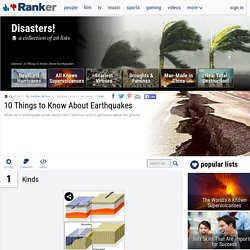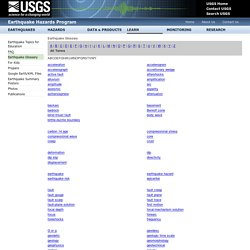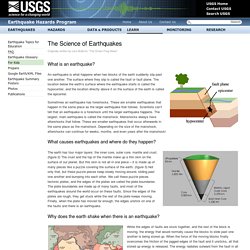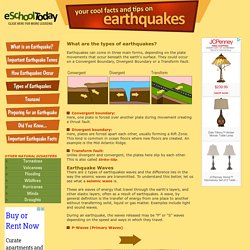

Everything to Know About Earthquakes. You Should:DROP down onto your hands and knees (before the earthquakes knocks you down).

This position protects you from falling but allows you to still move if necessary.COVER your head and neck (and your entire body if possible) under a sturdy table or desk. If there is no shelter nearby, only then should you get down near an interior wall (or next to low-lying furniture that won't fall on you), and cover your head and neck with your arms and hands.HOLD ON to your shelter (or to your head and neck) until the shaking stops. Be prepared to move with your shelter if the shaking shifts it around. You Should NOT:RUN OUTSIDE or to other rooms during shaking: The area near the exterior walls of a building is the most dangerous place to be. Windows, facades and architectural details are often the first parts of the building to collapse.
DO NOT stand in a doorway. DO NOT READ THE "TRIANGLE OF LIFE" email and believe it. Earthquake Glossary. Earthquake Hazards Program Earthquake Glossary A | B | C | D | E | F | G | H | I | J | K | L | M | N | O | P | Q | R | S | T | U | V | W | X | Y | ZAll Terms kinematic Share this page: U.S.

DOI and USGS link policies apply. Japanese earthquake in video. Globalseismichazardmap. Live Earthquakes Map. The Science of Earthquakes. What is an earthquake?

An earthquake is what happens when two blocks of the earth suddenly slip past one another. The surface where they slip is called the fault or fault plane. The location below the earth’s surface where the earthquake starts is called the hypocenter, and the location directly above it on the surface of the earth is called the epicenter. Sometimes an earthquake has foreshocks. These are smaller earthquakes that happen in the same place as the larger earthquake that follows. What causes earthquakes and where do they happen? The earth has four major layers: the inner core, outer core, mantle and crust. Why does the earth shake when there is an earthquake? While the edges of faults are stuck together, and the rest of the block is moving, the energy that would normally cause the blocks to slide past one another is being stored up.
The 10 deadliest earthquakes in history - World news - Asia-Pacific. A look at the worst earthquakes in recorded history, in loss of human life.

(The March 11, 2011, earthquake and tsumani that affected eastern Japan is not included because the fatalities caused, about 15,000, are fewer than those resulting from the temblors listed below.) Sources: United States Geological Survey, Encyclopedia Britannica 1: Shensi, China, Jan. 23, 1556 Magnitude about 8, about 830,000 deaths. This earthquake occurred in the Shaanxi province (formerly Shensi), China, about 50 miles east-northeast of Xi'an, the capital of Shaanxi. More than 830,000 people are estimated to have been killed.
Damage extended as far away as about 270 miles northeast of the epicenter, with reports as far as Liuyang in Hunan, more than 500 miles away. Types of earthquakes. What are the types of earthquakes?

Earthquakes can come in three main forms, depending on the plate movements that occur beneath the earth's surface. They could occur on a Convergent Boundary, Divergent Boundary or a Transform Fault. Convergent boundary: Here, one plate is forced over another plate during movement creating a thrust fault. Divergent boundary: Here, plates are forced apart each other, usually forming a Rift Zone. This kind is common in ocean floors where new floors are created. Transform fault: Unlike divergent and convergent, the plates here slip by each other. Earthquake Waves There are 2 types of earthquakes waves and the difference lies in the way the seismic waves are transmitted. These are waves of energy that travel through the earth's layers, and other elastic layers, often as a result of earthquakes. During an earthquake, the waves released may be “P” or “S” waves depending on the speed and ways in which they travel. P-Waves (Primary Waves)